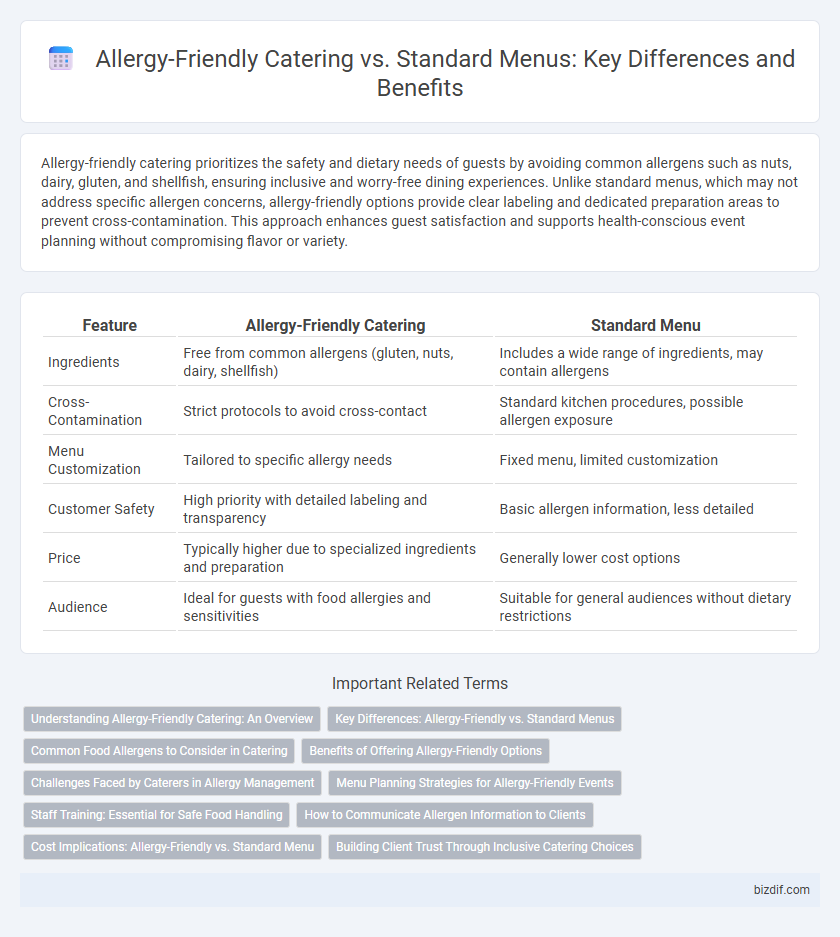Allergy-friendly catering prioritizes the safety and dietary needs of guests by avoiding common allergens such as nuts, dairy, gluten, and shellfish, ensuring inclusive and worry-free dining experiences. Unlike standard menus, which may not address specific allergen concerns, allergy-friendly options provide clear labeling and dedicated preparation areas to prevent cross-contamination. This approach enhances guest satisfaction and supports health-conscious event planning without compromising flavor or variety.
Table of Comparison
| Feature | Allergy-Friendly Catering | Standard Menu |
|---|---|---|
| Ingredients | Free from common allergens (gluten, nuts, dairy, shellfish) | Includes a wide range of ingredients, may contain allergens |
| Cross-Contamination | Strict protocols to avoid cross-contact | Standard kitchen procedures, possible allergen exposure |
| Menu Customization | Tailored to specific allergy needs | Fixed menu, limited customization |
| Customer Safety | High priority with detailed labeling and transparency | Basic allergen information, less detailed |
| Price | Typically higher due to specialized ingredients and preparation | Generally lower cost options |
| Audience | Ideal for guests with food allergies and sensitivities | Suitable for general audiences without dietary restrictions |
Understanding Allergy-Friendly Catering: An Overview
Allergy-friendly catering prioritizes the prevention of cross-contamination and the use of safe, allergen-free ingredients to accommodate diverse dietary restrictions, unlike standard menus that often include common allergens such as nuts, dairy, and gluten. Specialized allergen protocols and staff training are essential components, ensuring meal safety for guests with allergies. This tailored approach enhances inclusivity and health safety, reducing the risk of allergic reactions during catered events.
Key Differences: Allergy-Friendly vs. Standard Menus
Allergy-friendly catering prioritizes the exclusion of common allergens such as nuts, dairy, gluten, and shellfish to ensure safe dining experiences for individuals with food sensitivities, whereas standard menus typically do not specifically accommodate these restrictions. Allergy-friendly menus require meticulous ingredient sourcing and preparation protocols to prevent cross-contamination, contrasting with the more general food preparation methods found in standard catering. Nutritional labeling and clear allergen disclosures are integral to allergy-friendly catering but are often absent or less detailed in standard menu offerings.
Common Food Allergens to Consider in Catering
Catering services must prioritize identifying common food allergens such as peanuts, tree nuts, shellfish, milk, eggs, soy, wheat, and fish to ensure allergy-friendly options are safe for all guests. Allergy-friendly catering requires strict cross-contamination protocols and clear ingredient labeling to prevent adverse reactions. Offering specialized menus free from these allergens enhances guest safety and inclusivity compared to standard catering menus.
Benefits of Offering Allergy-Friendly Options
Offering allergy-friendly catering options significantly reduces the risk of allergic reactions, ensuring the safety and comfort of all guests during events. These tailored menus increase inclusivity and customer satisfaction by accommodating diverse dietary restrictions such as gluten-free, nut-free, and dairy-free needs. Providing allergy-friendly meals also enhances a catering service's reputation and expands its market by appealing to health-conscious and allergy-aware clients.
Challenges Faced by Caterers in Allergy Management
Caterers face significant challenges in managing allergy-friendly menus compared to standard offerings due to the risk of cross-contamination and the need for strict ingredient control. Accurate labeling and staff training are critical to prevent allergic reactions, requiring meticulous sourcing and preparation processes. Ensuring compliance with food allergy regulations demands constant vigilance and adaptation to diverse dietary restrictions in catering events.
Menu Planning Strategies for Allergy-Friendly Events
Menu planning for allergy-friendly catering requires detailed ingredient analysis and cross-contamination prevention protocols to ensure guest safety. Utilizing specialized suppliers and clearly labeling dishes with allergen information enhances trust and accessibility for individuals with food sensitivities. Customizable menu options and staff training on allergen management are critical components distinguishing allergy-friendly events from standard catering services.
Staff Training: Essential for Safe Food Handling
Staff training in allergy-friendly catering is crucial to prevent cross-contamination and ensure safe food handling practices. Employees must be proficient in identifying allergens, proper cleaning procedures, and communication protocols to accommodate guests with food allergies. Comprehensive training reduces the risk of allergic reactions and enhances customer trust in catering services.
How to Communicate Allergen Information to Clients
Clear communication of allergen information is critical in allergy-friendly catering to prevent cross-contamination and protect clients with dietary restrictions. Use detailed labeling on menus and provide written allergen guides highlighting common allergens like nuts, gluten, dairy, and shellfish. Training staff to effectively explain ingredient lists and respond to client inquiries ensures transparency and builds trust in food safety practices.
Cost Implications: Allergy-Friendly vs. Standard Menu
Allergy-friendly catering often incurs higher costs due to specialized ingredient sourcing, rigorous cross-contamination prevention, and customized meal preparation, which require additional labor and resources compared to standard menus. This investment ensures compliance with health regulations and reduces the risk of allergic reactions, potentially minimizing costly liability issues for event organizers. While standard menus benefit from bulk purchasing and streamlined processes, allergy-friendly options prioritize safety and inclusion, reflecting a trade-off between cost-efficiency and personalized dietary accommodations.
Building Client Trust Through Inclusive Catering Choices
Offering allergy-friendly catering options alongside a standard menu demonstrates a commitment to client health and safety, fostering trust and loyalty. Inclusive catering choices reduce the risk of allergic reactions, ensuring a positive experience for all guests and enhancing the event's reputation. Transparent communication about ingredient sourcing and preparation further reinforces client confidence and satisfaction.
allergy-friendly catering vs standard menu Infographic

 bizdif.com
bizdif.com